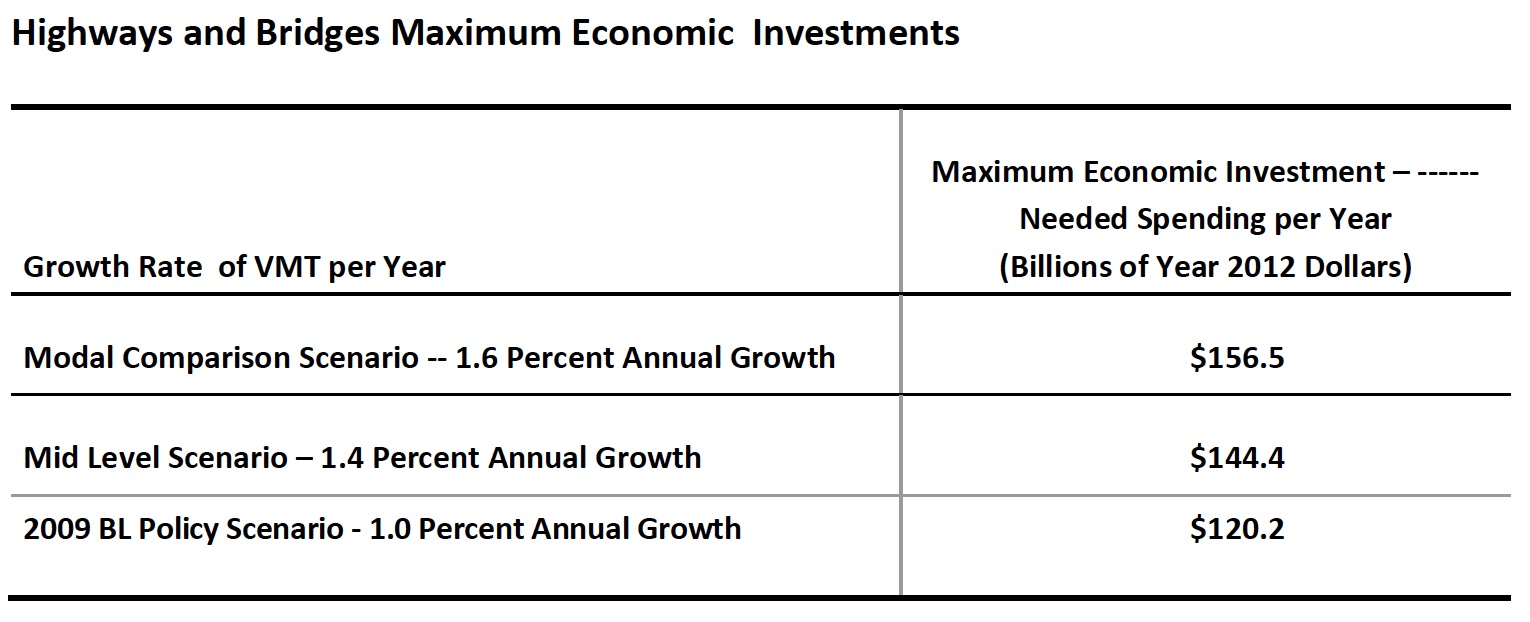AMERICAN ASSOCIATION OF STATE HIGHWAY AND TRANSPORTATION OFFICIALS (AASHTO)
An annual investment of $120 billion for highways and bridges between 2015 and 2020 is necessary to improve the condition and performance of the system, given a rate of travel growth of 1.0 percent per year in vehicle miles of travel, which has been AASHTO’s sustainability goal, and which represents the likely impacts of both population growth and economic recovery.
If travel growth is at 1.4 percent per year, which carries forward the rate employed in the 2009 Bottom Line and is consistent with the long term trend from 1995 to 2010, and has been indicated in recent months, then needed investment to improve the highway and bridge system will be $144 billion per year.
In 2010, the most recent year for which full data has been compiled by the Federal Highway Administration, highway capital investment from sources other than the American Recovery and Reinvestment Act, totaled $88.3 billion per year, but future funding levels are now highly uncertain.
An annual investment of $43 billion for public transportation is necessary to improve system performance and condition, given an expected 2.4 percent annual growth in transit passenger miles of travel.
If transit ridership growth rises to 3.5 percent, the level that would double transit passenger miles of travel in 20 years, investment in public transportation capital would have to increase to $56 billion per year.
In 2011, transit capital investment from all levels of government totaled $17.1 billion, according to APTA.
The model based investment estimates do not include all needs. Highway operations investments, safety and security, and environmental mitigation costs for highways and transit capital projects may add over $10 billion per year to annual investment costs, although these are not compiled for all systems and agencies. Importantly, long term highway reconstruction costs may also not be fully captured.
The highway and bridge backlog required to restore the system to the level of condition and performance required to meet today’s demand is $740 billion: of that amount the highway system rehabilitation backlog accounts for $392 billion; the highway system capacity expansion backlog accounts for $237 billion; and the bridge rehabilitation backlog accounts for $112 billion.
The highway system rehabilitation value of $392 billion plus bridges at $112 billion, is roughly comparable in concept to the transit state of good repair (SGR) backlog approach, which has a value of $77.7 billion. The FTA has not calculated a transit system capacity expansion backlog.
Recent research “A Failure To Act” sponsored by the American Society of Civil Engineers on the economic impacts of investing to improve conditions and performance of highways and public transportation indicated that the average US household will benefit by a cumulative $157,000 extra income between 2012 and 2040 compared to current levels of highway and transit investment, which is more than three times current median household income.
An economic analysis for APTA of the transit investments in the 2009 Bottom Line report showed that the marginal return from investing additional dollars in transit capital was 3.7 times the incremental cost of those investments.
FHWA’s condition and performance report for 2010 showed that by the end of the 20 year analysis period, the annual user cost savings from higher levels of highway investment were 2.6 to 3.8 times as great as the annual added investment over current levels.
Between 1991 and 2011, both highway vehicle miles of travel and transit passenger miles of travel increased at a long term average annual rate of 1.6 percent.
Highway travel declined during the recession and its aftermath, and has slowly resumed growth since 2011, reaching an annual increase of only 0.6 percent in 2013 and transit travel grew only 1.1 percent in 2013, reflecting the slow beginning of the economic recovery from the great recession.
Highway travel is expected to reach 3 trillion miles of travel again in 2014 not seen since 2008.
In 2011, the freight transported in America was 17.6 billion tons, with 64 percent by truck, and freight ton miles are expected to grow 72 percent from 2015 to 2040.
In 2013, transit passengers totaled 10.7 billion, the highest level since 1956.
International tourism, an intense user of our transportation system, generated $181 billion for the US in 2013.
Transportation industries employ more than 11.7 million persons.
Since 1950, the population of the United States more than doubled but the road system grew only from 3.3 million miles to 4.1 million miles.
The number of motor vehicles in the United States has quadrupled from around 65 million at the start of the Interstate in 1956 to 254 million in 2012.
The overall population of the US is anticipated to grow by 37 million from 2010 to 2025, but the over 65 population is expected to grow by 25 million, the under 18 population by 4 million, and the working age population of 18 to 64 by only 8 million.
Structurally deficient bridges have declined by 43% from 1994 to 2013, but 63,500 SD bridges remain.
Highway fatalities have decreased from 41,000 in 2007 to an estimate of below 33,000 in 2013.
Download full version: 2015 AASHTO Bottom Line Report
About the American Association of State Highway and Transportation Officials
www.transportation.org
AASHTO is a nonprofit, nonpartisan association representing highway and transportation departments in the 50 states, the District of Columbia, and Puerto Rico. It represents all five transportation modes: air, highways, public transportation, rail, and water. Its primary goal is to foster the development, operation, and maintenance of an integrated national transportation system.
Tags: AASHTO, American Association of State Highway and Transportation Officials, American Public Transportation Association, APTA







 RSS Feed
RSS Feed